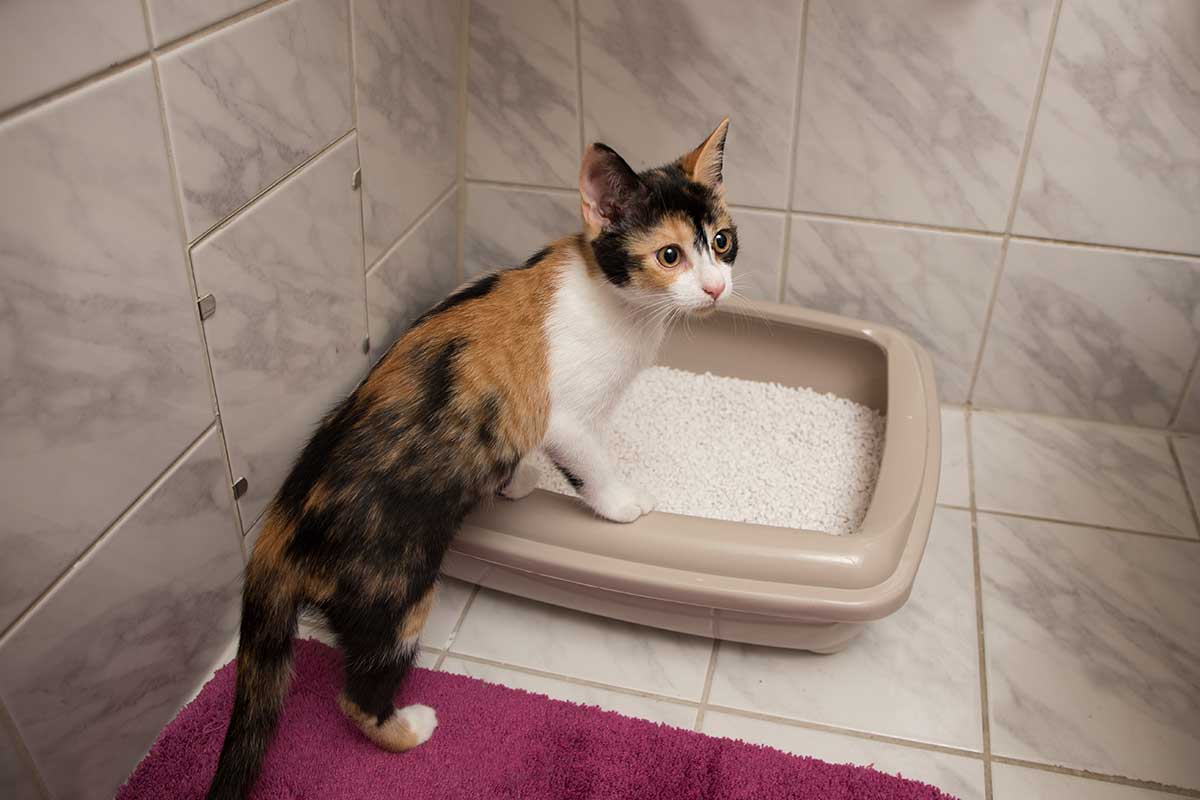Cats are great! They are independent but affectionate, playful but restful, and they don’t need to go outside to eliminate—one of the biggest positives for people who appreciate our feline overlords.
Sometimes, though, cats stop peeing or pooping inside the litter box. In worst-case scenarios when this occurs, they are relinquished to shelters or re-homed. Cats who don’t use the litter box may be avoiding it for behavioral reasons or medical conditions, which is why you should discuss the problem with your veterinarian as soon as it occurs.
Your veterinarian will start by ruling out any medical conditions such as a urinary tract infection, parasites, or other systemic diseases by obtaining lab work such as a blood chemistry profile, complete blood cell count, and a urinalysis (at minimum). Once medical concerns are ruled out, they can focus on the behavior aspect and evaluate the cat’s environment.
Many cats eliminate outside of the box because they are stressed, but some simply reject a dirty litter box. And who can blame them!
I’m here to share the secrets of what cats look for in the “Golden Throne”: the ideal litter box. Their wish list includes a desirable location (desirable to cats, not to humans), a box of appropriate size and type, and the perfect litter. The goal is to set cats and cat lovers up for success to keep felines in their homes for the long haul!
Litter Box Design and Location
Place litter boxes in low-traffic areas that seem safe to cats. In other words, not near loud household appliances such as washers, dryers, furnaces, dishwashers, air conditioners, or toilets. All these items have the potential to interrupt a cat’s normal elimination process and make him want to find a place where he won’t be startled.
Cats also prefer places where they won’t feel trapped. This is important if they share the household with another cat or dog, who might take the opportunity to attack while they’re squatting in a vulnerable position. Avoid areas where cats have no route of escape.
An example of a low-traffic, safe, quiet location may be a rarely used spare bedroom or bathroom. You can also purchase products that resemble furniture but actually hide the litter box. This may seem ideal to you, but it may also mean the litter box is in a higher traffic location. Every living being prefers privacy for elimination, especially cats.
Litter box design preferences differ from cat to cat and human to human. Most cats prefer an open litter box. Most cat owners prefer a covered litter box. Covered boxes may trap odors and make the human environment more pleasant, but it may not be as desirable for the cat. If boxes are not cleaned regularly, scent and odor can linger, causing cats to avoid them.
Most open litter boxes are too small for the average cat. The litter box should be one and a half times the length of the cat’s body. Think outside the box, so to speak: good alternatives include plastic storage containers, dog litter boxes (your cat won’t know the difference, we promise), or cement-mixing pans. Make sure the sides of the box are low enough that the cat can jump in easily. Self-cleaning litter boxes, while convenient, make noises and movements that can scare cats, so take that into consideration.
Litter Preference
There are many different types of cat litter: scented; unscented; clay granules; soft sandlike litter; litter pearls; litter made of wheat, newspaper, sawdust, even pine. In a study by a veterinary behaviorist, it was found that cats generally prefer unscented clumping litter beneath their paws.
Although scented litters may be more desirable for us humans, it can be overpowering to cats—and not in a good way. Feline sensitivity to smells is much higher than that of humans and therefore, scented litters rank lower on the list.
For some cats, crystal-type litter can contribute to fear of the litter box. When the cat eliminates, the crystals can “pop,” creating a startling sound. The cat may then associate it with the litter box, causing more problems in the long run.
Our best advice? Go with what the cat likes. Give her some options and let her choose.
How to Clean When Flushing Isn’t an Option
Scoop litter boxes once or twice daily. Cats don’t want to set paw in a litter box filled with yesterday’s urine clumps and stool piles. We’re guessing you wouldn’t either.
To make boxes as attractive as possible for your cat to use, at least once a month dump old litter, clean the box with a mild, unscented detergent and warm water, and refill with fresh litter. Avoid using any strongly scented cleansers.
Recommendations for Multi-Cat Homes
Everything is the same except for this one important rule of paw: provide a box for each cat, plus one extra. Place boxes on separate floors or in separate rooms to prevent one cat from blocking access to a box.
Keep in mind, too, that using covered boxes in multi-cat homes can create some increased anxiety. Cats inside covered boxes can’t tell if another cat is sneaking up on them. If there is low-level aggression between the cats, and the victim cat is attacked when coming out of the box, the experience can create a negative association with the litter box. In multi-cat homes, open litter boxes are best.
This article was reviewed/edited by board-certified veterinary behaviorist Dr. Kenneth Martin and/or veterinary technician specialist in behavior Debbie Martin, LVT.








